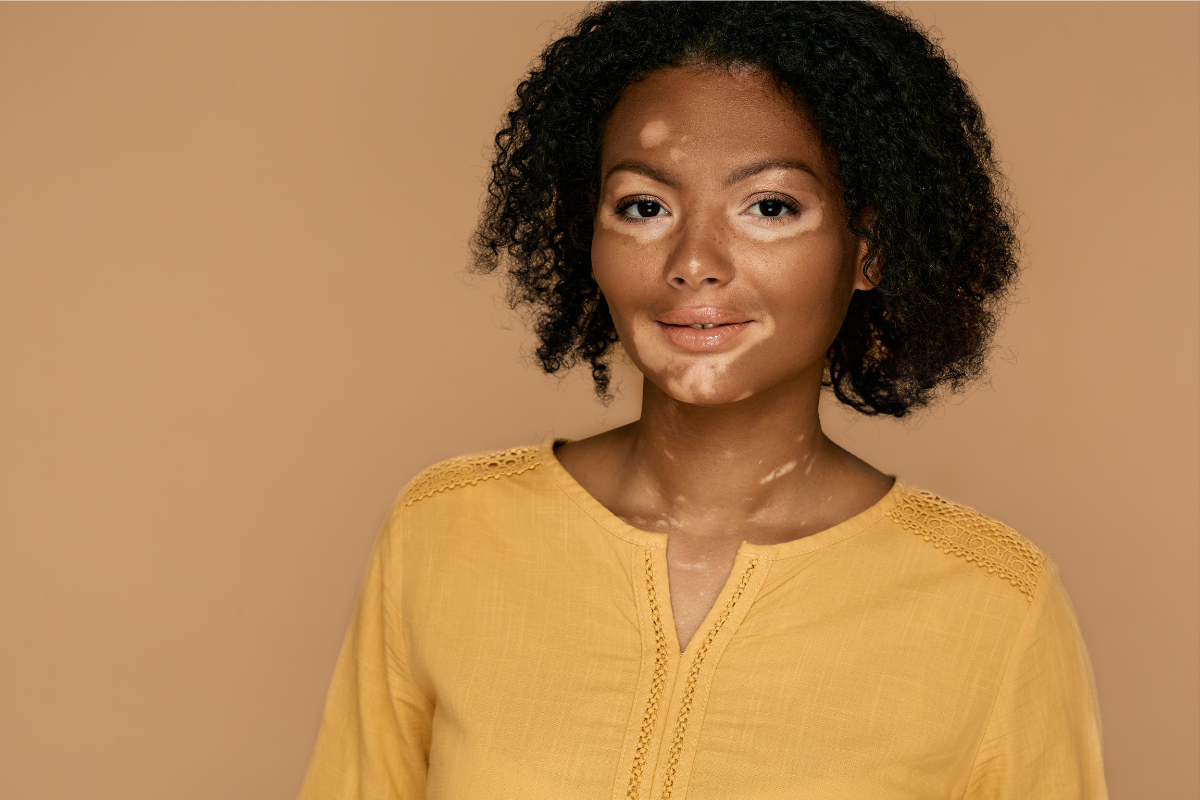Vitiligo: what is it and what are the first symptoms?

Table of Contents
What is vitiligo?
Vitiligo is a chronic, non-contagious condition in which areas of the skin on various parts of the body become discolored, resulting in the appearance of white spots. [1][2]
Specifically, areas where it appears are:[1]
- areas exposed to sunlight (hands, feet, face)
- in the genitals
- on the mucous membrane inside the mouth
- in the nostrils
- in the area behind the ears
- in the armpits
- around the mouth and eyes
It is worth noting that, if it appears in areas with hair growth, the hairs acquire a white color. Vitiligo occurs in children and adults, usually between the ages of 20 and 30 years old, in both men and women. However, it is more noticeable in people who have dark skin.
The cause of this disease remains unclear and is characterized as an autoimmune disorder.
Vitiligo first symptoms
Early symptoms of vitiligo include:[2][3]
- Patchy loss of skin color, which usually first appears on the hands, face and areas around the elbows, knees and genitals.
- Premature graying of the hair on your scalp, eyelashes, eyebrows or beard.
- Loss of color in the tissues lining the inside of the mouth and nose (mucous membranes).
It can start at any age, but usually appears before 30s. Most commonly, the first white spot that is noticed is often an area of the body that is exposed to the sun.
Vitiligo starts as a simple white mark, slightly paler than the rest of the skin, but over time, this spot becomes lighter, until it turns white. These white spots on the skin are usually irregular in shape. The edges can sometimes become irritated and take on a red tone that is visible on all skin types and rarely itches.
In a more general context, it does not cause any discomfort, irritation, pain or dryness on the skin.
Vitiligo types
There are two main types of vitiligo:[1][4]
1. Nonsegmental or generalized vitiligo:
It is the most common type and occurs when white patches on the skin appear symmetrically on both sides of your body, such as on both hands or both knees.
This type of vitiligo can have a rapid loss of color or pigment and tends to cover a large area. Nonsegmental vitiligo is divided into subtypes based on how the condition appears:
- Perifacial vitiligo, which appears on the face, hands and feet.
- Mucosal vitiligo, which affects the mucous membranes of the mouth, nose and genitals.
- Vitiligo universalis, which can involve 80-90% of an affected person’s skin, according to a review in the journal Dermatology.
- Localized or focal vitiligo, which occurs in only a few areas of the body.
2. Segmental vitiligo
It is less common and occurs when the white patches on the skin are only on one part or one side of the body, such as one leg, one side of the face, or one arm.
This type of vitiligo often starts at a young age and progresses for about 1 to 2 years and then usually stops.
The diagnosis of vitiligo is usually made by the clinical picture. Less commonly, a biopsy may be needed for differential diagnosis from other conditions that cause hypochromia and round white spots, such as mycosis fungoides and pityriasis versicolor.
It is noted that the white marks on the skin can also be a fungal infection (dermatophytes). Of course, the specialist dermatologist is responsible for judging and evaluating the situation.
What causes vitiligo?
Researchers characterize vitiligo as an autoimmune disease. In short, certain cells of the immune system attack the skin cells that produce the pigment melanin (melanocytes), resulting in the formation of white spots.
But why would our immune system cells attack the skin cells that produce melanin?
That question has yet to be fully answered, according to the American Academy of Dermatology. However, there are factors that predispose the onset of this autoimmune disorder.
Specifically:[5]
1. Family history and genes
About 20% of people with vitiligo have at least one close relative affected by this skin disorder, and researchers have found that having a certain genetic profile makes people more prone to developing vitiligo. Mutations have been identified in more than 30 genes associated with vitiligo, which are involved in the regulation of the immune and inflammatory response.
2. Environmental triggers
Vitiligo appears to be the result of both a pre-existing genetic makeup and a factor in the environment that triggers an autoimmune response that destroys melanocytes. Possible triggers include;
- sunburn
- exposure to certain chemicals
- and skin injury
These triggers can also cause vitiligo to spread in people who already have the condition.
3. A pre-existing autoimmune disease
People with an autoimmune disease, are at increased risk of developing vitiligo, notes the American Academy of Dermatology. These can be:
- psoriasis
- systemic lupus erythematosus
- Hashimoto’s disease
- alopecia areata
In addition, many vitiligo-related genes are also linked to other autoimmune diseases, such as:
- rheumatoid arthritis,
- type 1 diabetes
- and thyroid disease
4. A highly stressful event
Very often, the person may be predisposed to develop the disease, but develop it only after experiencing a very intense and stressful situation.
Vitiligo treatment
Treatments for vitiligo aim to restore the color balance in the skin. Clearly, treatment options vary according to[1]:
- the seriousness of the situation
- the location and size of the white spots
- the number of spots
- the response to each treatment
We note that the treatment of this autoimmune disorder should be individualized according to the patient, taking into account the benefit of the treatment compared to the possible side effects of each of them.
Non-invasive treatment
You will usually need at least 3 months of treatment to see results. The most common medical treatments include:[1]
- Topical creams
- Psoralen and ultraviolet A (PUVA)
- Oral medication
- Narrow band ultraviolet B (UVB) therapy
- Excimer laser treatment
- Discoloration (when most of the body is already discolored by the diesease)
Surgical method
Surgical options are recommended when medications and phototherapy do not work. According to a 2021 study, types of surgery include:[1]
- Skin transplant
- Melanocyte transplant
- Micropigmentation
Vitiligo and diet
Recent research data prove that the right nutritional habits achieve a better management of autoimmune diseases, such as vitiligo. Experts recommend the following:
Eat nutrient-dense foods
Nutrient deficiencies can be a reason for vitiligo flare-ups. For this reason, it is recommended to follow a nutritious diet with:
- lean meat,
- healthy fats such as oily fish and extra virgin olive oil,
- plenty of vegetables,
- shellfish and algae.
Consume plenty of antioxidants
Antioxidants help reduce skin damage, so eating antioxidant-rich foods and drinks can be extremely beneficial. For examples:
- cocoa
- green tea
- dark vegetables and fruits
- nuts
There may be a link between celiac disease and vitiligo
One study found that when gluten was removed from the diet of children with celiac disease and vitiligo, repigmentation occurred in some of them.
Νutritional supplements
A recent review published in the Journal of Alternative and Complementary Medicine looked at 26 studies to find any evidence regarding dietary changes and the use of natural nutritional supplements to manage vitiligo. [6][7]
Herbs for vitiligo
Overall, the review did not identify specific dietary recommendations, but suggested that Ginkgo biloba and Polypodium leucotomos in combination with traditional therapy may improve symptoms of vitiligo.
The Vitiligo Research Foundation also suggests that these herbs may be helpful when combined with ongoing treatment to prevent recurrence of the disease.
Recent data suggest how green tea polyphenols may be useful in the treatment of vitiligo, in interrupting the oxidative stress of the melanocyte unit.
Vitamin D
Another small study found that a high-dose Vitamin D dietary supplement can increase pigmentation in people with vitiligo who are deficient in this vitamin.
Antioxidants
According to a review from 2021, researchers found that oral antioxidant therapy may be beneficial for skin conditions, including vitiligo.
The review concluded that antioxidants, particularly vitamin E, combined with phototherapy (use of ultraviolet light) may be beneficial in disease management.
According to the Vitiligo Research Foundation, many people with the condition are more likely to be deficient in vitamin D, vitamin B12, folate, copper and zinc.
The effectiveness of long-term, high-dose nutritional supplementation remains unclear. Further clinical studies are needed to draw safer conclusions.
Vitiligo in children
As mentioned, vitiligo affects people of any gender, skin color and can appear at any age. However, many patients begin to experience the pigmentation changes before the age of 20, and some even begin in early childhood. [8]
Segmental vitiligo affects about 30% of children with vitiligo. In children, diagnosing vitiligo requires a thorough history and physical exam, during which the doctor will ask questions about family medical history and examine the skin closely.
What is known is that the risk of developing vitiligo is increased in children with a family history of vitiligo or a history of thyroid disease, diabetes and certain other autoimmune conditions such as alopecia areata. [9]
Psychology
If the skin spots are visible, the “social stigma” of vitiligo can make it more difficult to treat. Studies indicate that a large number of people suffering from this condition show symptoms of anxiety and depression. Intense stress, however, in turn triggers the spread of vitiligo.
So we understand that positive psychology plays a decisive role in a person’s quality of life. In addition, increasing vitiligo awareness, e.g. talking to friends about it and looking for role models who have vitiligo can help better overcome difficulties.
Find at Vita4you.gr products for vitiligo.
Sources
- What Is Vitiligo?
- Vitiligo
- Understanding the symptoms of vitiligo
- ΝΙΗ: Vitiligo
- What Is Vitiligo? Symptoms, Causes, Diagnosis, Treatment, and Prevention
- What to Eat When You Have Vitiligo
- Herbal Compounds for the Treatment of Vitiligo: A Review
- Overview of Vitiligo in Children
- Vitiligo
- Can diet help vitiligo?
Disclaimer
The content of this blogspot is not and can not be considered as medical advice, diagnosis or treatment. All information is provided to readers solely for informational purposes. There is no intention to substitute this content for personalized medical advice, diagnosis, prognosis or treatment.






Leave a comment